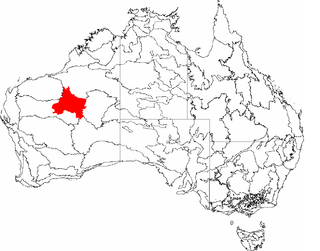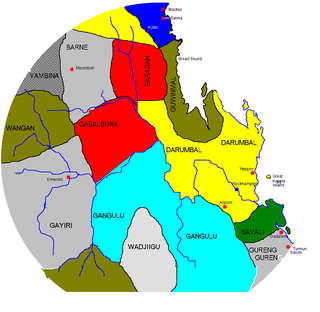Related Research Articles
The Tjurabalan (Jura-palan) is a nomadic desert tribe from the edge of the Tanami Desert near Sturt Creek and The Paraku Lake system, Lake Gregory in the Kimberley region of Western Australia.

The Little Sandy Desert (LSD) is a desert region in the state of Western Australia, lying to the east of the Pilbara and north of the Gascoyne regions. It is part of the Western Desert cultural region, and was declared an interim Australian bioregion in the 1990s.
Walmajarri is a Pama–Nyungan language spoken in the Kimberley region of Western Australia by the Walmadjari and related peoples.
The Martu (Mardu) are a grouping of several Aboriginal Australian peoples in the Western Desert cultural bloc.

Balgo, previously Balgo Hills and Balgo Mission, is a community in Western Australia that is linked with both the Great Sandy Desert and the Tanami Desert. The community is in the Shire of Halls Creek, off the Tanami Road, and was established by German missionaries in 1939. In the 2021 census Balgo's population numbered 430.
The National Native Title Tribunal (NNTT) is an independent body established under the Native Title Act 1993 in Australia as a special measure for the advancement and protection of Aboriginal and Torres Strait Islander peoples. It manages applications for and administration of native title in Australia.

An Indigenous Protected Area (IPA) is a class of protected area used in Australia; each is formed by voluntary agreement with Indigenous Australians, and declared by Aboriginal Australians and Torres Strait Islander representative organisations. Each is formally recognised by the Australian Government as being part of its National Reserve System. The areas may comprise land and sea, and are managed by Indigenous groups for the conservation of biodiversity. Managing IPAs also helps to protect the cultural values of their country for future generations, and has benefits for Indigenous health, education, economic and social cohesion.

Kunawarritji is an Aboriginal community, located in the Pilbara region of Western Australia, within the Shire of East Pilbara on the Canning Stock Route.
Jigalong is a remote Aboriginal community of approximately 333 people located in the Pilbara region of Western Australia.
Land councils, also known as Aboriginal land councils, or land and sea councils, are Australian community organisations, generally organised by region, that are commonly formed to represent the Indigenous Australians who occupied their particular region before the arrival of European settlers. They have historically advocated for recognition of traditional land rights, and also for the rights of Indigenous people in other areas such as equal wages and adequate housing. Land councils are self-supporting, and not funded by state or federal taxes.
A Registered Native Title Body Corporate (RNTBC) is a corporation nominated by a group of Aboriginal or Torres Strait Islander people for the purposes of native title in Australia, to represent their native title rights and interests, once that group's native title application has been recognised in a Federal Court of Australia determination, and the corporate body registered. The corporation nominated hold and manage or manage before native title determination and registration, is called a Prescribed Body Corporate (PBC).
Mulan is a small Aboriginal community in Western Australia's east Kimberley. The community is in the Shire of Halls Creek, 44 km to the southwest of Balgo and about 10 km east of Lake Gregory. At the 2006 census, Mulan had a population of 114.

The Nyikina people are an Aboriginal Australian people of the Kimberley region of Western Australia.

Punmu is an Aboriginal community, located 640 km south east of Port Hedland in the Pilbara region of Western Australia, within the Shire of East Pilbara.
The Mangarla, or Mangala, are an Aboriginal Australian people of Western Australia. The Mangarla people traditionally lived in the north-western area of the Great Sandy Desert, west of the Karajarri people, east of the Walmajarri, with the Juwaliny and Yulparija to the south. Many Mangarla people now live in Jarlmadangah and Bidyadanga.

The Gabulbarra people, also rendered Gabalbura, Gabalbara and Kabalbara, were an Aboriginal Australian people of an area in eastern Central Queensland, but there is little recorded information about them.
The Kokatha, also known as the Kokatha Mula, are an Aboriginal Australian people of the state of South Australia. They speak the Kokatha language, close to or a dialect of the Western Desert language.
The Ngururrpa Indigenous Protected Area, covering an area of 29,000 square kilometres (11,000 sq mi) in the far eastern area of the Pilbara region, in the Great Sandy Desert of Western Australia, was declared in October 2020. It includes all of the land included in the Ngururrpa native title area, as determined in 2007.
Ngarralja Tommy May is an Indigenous Australian artist. He won the 2020 NATSIAA Telstra Award for his tin-etching art, 'Wirrkanja'.
The Birriliburu Indigenous Protected Area, also known as Birriliburu IPA, is an Indigenous Protected Area (IPA) covering an area of 6,600,000 hectares in the Western Desert region of Western Australia, was declared in 2013.
References
- ↑ Tran Tran 2016, p. 167.
- 1 2 3 "New Ngururrpa Indigenous Protected Area". Country Needs People. 1 August 2018. Retrieved 14 May 2021.
- ↑ Musharbash 2008, p. 35.
- ↑ KLC 2016.
- ↑ Tran 2016, p. 166.
- ↑ Brooks 2003.
- ↑ Anker 2008, pp. 53–56.
- ↑ Ngurrarra 2016.
- 1 2 Native Title Claimant Applications and Determination Areas, as per the Federal Court (31 March 2021) (PDF) (Map). National Native Title Tribunal. 23 April 2021.
Creative Commons Attribution 3.0 Australia licence.
- ↑ "Ngurra Kayanta". Central Desert Native Title Services. 21 February 2021. Retrieved 15 May 2021.
- ↑ "Ngururrpa". Central Desert Native Title Services. 15 July 2016. Retrieved 15 May 2021.
- ↑ "Parna Ngururrpa (Aboriginal Corporation) RNTBC". PBC. Retrieved 15 May 2021.
- ↑ O'Connor, Ted (12 May 2021). "Ngururrpa people in Great Sandy Desert celebrate land becoming Indigenous Protected Area". ABC News (Australian Broadcasting Corporation). Retrieved 14 May 2021.
- ↑ "Ngururrpa IPA". National Indigenous Australians Agency . 12 October 2020. Retrieved 15 May 2021.
Sources
- "AIATSIS map of Indigenous Australia". AIATSIS. 14 May 2024.
- Anker, Kirsten (2008). "The Law of the Other: Exploring the Paradox of Legal Pluralism in Australian Native Title". In Lagayette, Pierre l (ed.). Rencontres australiennes: regards croisés sur l'identité d'un peuple et d'une nation. Presses Paris Sorbonne. pp. 39–55. ISBN 978-2-840-50541-9.
- Brooks, Geraldine (28 July 2003). "The Painted Desert: How Aborigines turned ancient rituals into chic contemporary art". The New Yorker .
- Musharbash, Yasmine (2008). Yuendumu Everyday: Contemporary Life in Remote Aboriginal Australia. Aboriginal Studies Press. ISBN 978-0-855-75661-1.
- "Native Title Map-Ngurrara". Kimberley Land Council. 2016.
- "Ngurrarra". Yanunijarra Aboriginal Corporation. 2016.
- "Tindale Tribal Boundaries" (PDF). Department of Aboriginal Affairs, Western Australia. September 2016.
- Tran, Tran (2016) [First published 2015]. "The (Non-Legal) Guide to Meaningful Recognition: A Case Study from the Canning Basin, Western Australia". In Sillitoe, Paul (ed.). Indigenous Studies and Engaged Anthropology: The Collaborative Moment. Routledge. pp. 163–179. ISBN 978-1-317-11722-3.